Analysis of Leadership, Models, and Organisational Change Assignment
VerifiedAdded on 2022/08/22
|6
|968
|14
Homework Assignment
AI Summary
This assignment delves into the intricacies of organisational change and leadership. It begins by defining and describing four key leadership roles identified by Caldwell (2013). The assignment then analyzes a video on consulting, identifying and explaining three crucial issues that consultants face. It further explores the assumptions underlying Beer & Spector's (1993) learning diagnosis model and discusses its appropriate applications. The assignment also examines Seidman's (1998) paper, highlighting and explaining three significant issues raised within it. Finally, it discusses Kahn's (2012) functional diagnostic model, including its assumptions and ideal use cases, offering a comprehensive understanding of the subject matter.
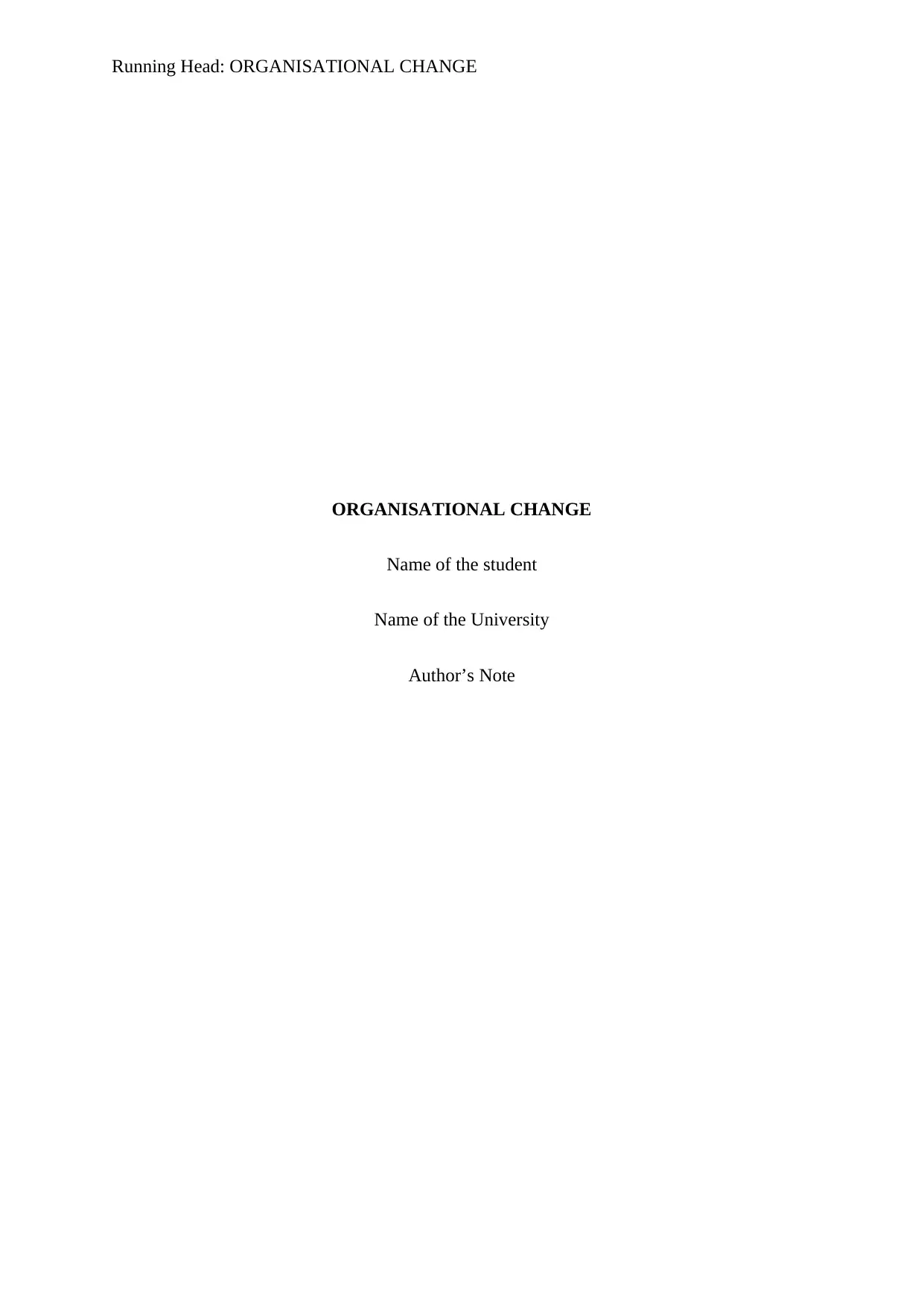
Running Head: ORGANISATIONAL CHANGE
ORGANISATIONAL CHANGE
Name of the student
Name of the University
Author’s Note
ORGANISATIONAL CHANGE
Name of the student
Name of the University
Author’s Note
Paraphrase This Document
Need a fresh take? Get an instant paraphrase of this document with our AI Paraphraser
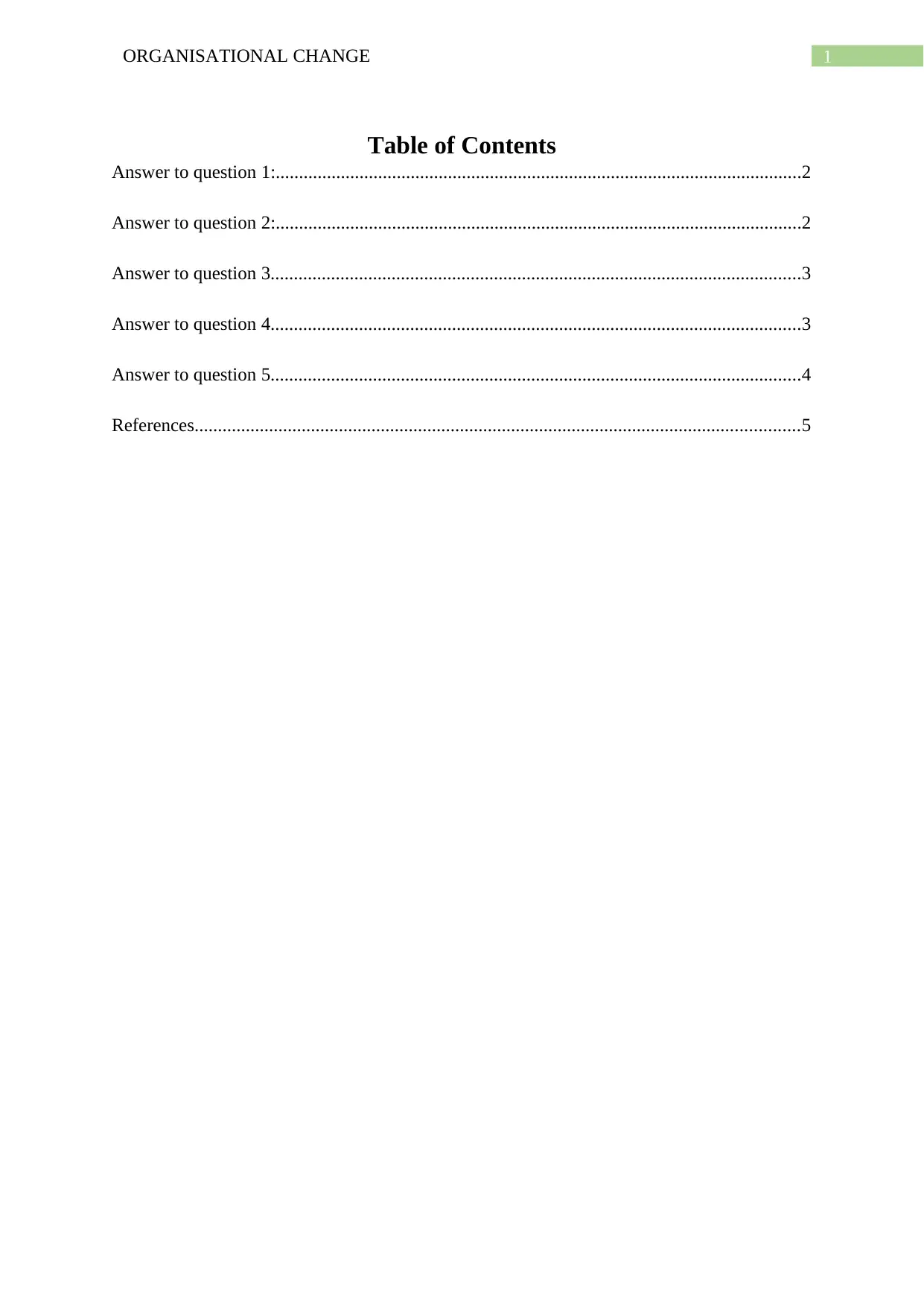
1ORGANISATIONAL CHANGE
Table of Contents
Answer to question 1:.................................................................................................................2
Answer to question 2:.................................................................................................................2
Answer to question 3..................................................................................................................3
Answer to question 4..................................................................................................................3
Answer to question 5..................................................................................................................4
References..................................................................................................................................5
Table of Contents
Answer to question 1:.................................................................................................................2
Answer to question 2:.................................................................................................................2
Answer to question 3..................................................................................................................3
Answer to question 4..................................................................................................................3
Answer to question 5..................................................................................................................4
References..................................................................................................................................5

2ORGANISATIONAL CHANGE
Answer to question 1:
Four Leadership roles are as follows (Caldwell, 2013):
1. Inspire Trust: Inspiring the trust of the employees is the major role that any leader
should and must play. A leader should be a credible one who others choose to follow.
He should be a person with both character and competence.
2. Create Vision: A leader should have a clear picture of where his organisation is and
where it aims to reach. This role of a leader allows him to define the vision for the
employees in order to achieve the organisational goal.
3. Execute Strategy: The role of the leader does not end with defining the vision or the
path his team needs to follow. It requires him to consistently achieve these results
with others using effective strategies.
4. Coach potential: A leader should be the one who has the ability to make his team
more productive and self-sufficient. He should be able to unleash the ability that each
member in his team to enhance their performance and growth.
Answer to question 2:
Three key issues discussed in the video are as follows:
1. Building trust between the consultant and the clients. Trust is the main issue that is
faced the client. When a client comes to the consultant he comes with the trust that his
issue will be resolved. Hence, the main focus of the consultant should be building that
trust between them so that the client is satisfied and considers visiting him again.
2. Good Communication: Good communication is the key to build trust. A consultant
that cannot communicate well will never be able to understand the problem faced by
the client and will not be able to guide him properly. Hence, it is the job of the
Answer to question 1:
Four Leadership roles are as follows (Caldwell, 2013):
1. Inspire Trust: Inspiring the trust of the employees is the major role that any leader
should and must play. A leader should be a credible one who others choose to follow.
He should be a person with both character and competence.
2. Create Vision: A leader should have a clear picture of where his organisation is and
where it aims to reach. This role of a leader allows him to define the vision for the
employees in order to achieve the organisational goal.
3. Execute Strategy: The role of the leader does not end with defining the vision or the
path his team needs to follow. It requires him to consistently achieve these results
with others using effective strategies.
4. Coach potential: A leader should be the one who has the ability to make his team
more productive and self-sufficient. He should be able to unleash the ability that each
member in his team to enhance their performance and growth.
Answer to question 2:
Three key issues discussed in the video are as follows:
1. Building trust between the consultant and the clients. Trust is the main issue that is
faced the client. When a client comes to the consultant he comes with the trust that his
issue will be resolved. Hence, the main focus of the consultant should be building that
trust between them so that the client is satisfied and considers visiting him again.
2. Good Communication: Good communication is the key to build trust. A consultant
that cannot communicate well will never be able to understand the problem faced by
the client and will not be able to guide him properly. Hence, it is the job of the
⊘ This is a preview!⊘
Do you want full access?
Subscribe today to unlock all pages.

Trusted by 1+ million students worldwide
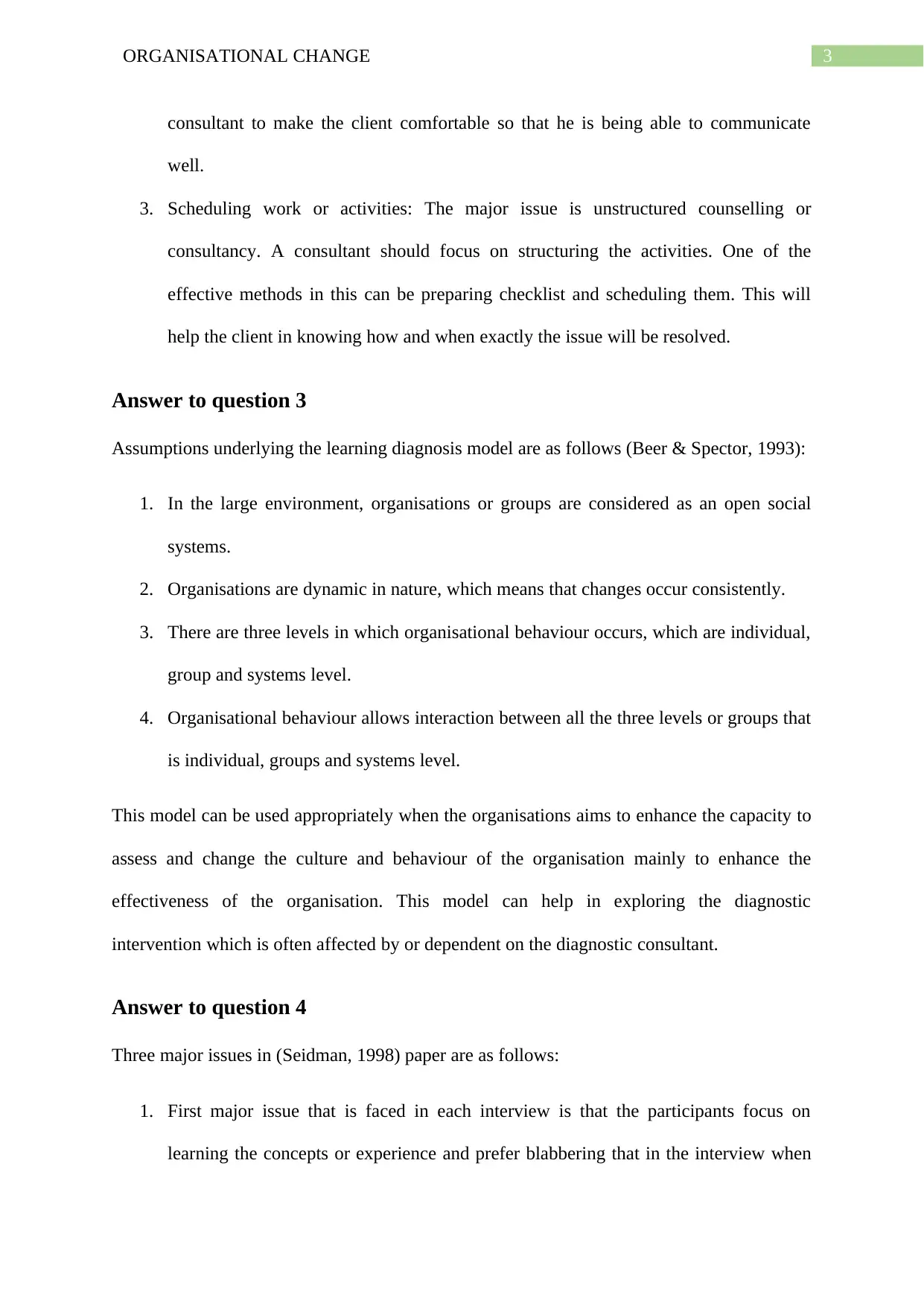
3ORGANISATIONAL CHANGE
consultant to make the client comfortable so that he is being able to communicate
well.
3. Scheduling work or activities: The major issue is unstructured counselling or
consultancy. A consultant should focus on structuring the activities. One of the
effective methods in this can be preparing checklist and scheduling them. This will
help the client in knowing how and when exactly the issue will be resolved.
Answer to question 3
Assumptions underlying the learning diagnosis model are as follows (Beer & Spector, 1993):
1. In the large environment, organisations or groups are considered as an open social
systems.
2. Organisations are dynamic in nature, which means that changes occur consistently.
3. There are three levels in which organisational behaviour occurs, which are individual,
group and systems level.
4. Organisational behaviour allows interaction between all the three levels or groups that
is individual, groups and systems level.
This model can be used appropriately when the organisations aims to enhance the capacity to
assess and change the culture and behaviour of the organisation mainly to enhance the
effectiveness of the organisation. This model can help in exploring the diagnostic
intervention which is often affected by or dependent on the diagnostic consultant.
Answer to question 4
Three major issues in (Seidman, 1998) paper are as follows:
1. First major issue that is faced in each interview is that the participants focus on
learning the concepts or experience and prefer blabbering that in the interview when
consultant to make the client comfortable so that he is being able to communicate
well.
3. Scheduling work or activities: The major issue is unstructured counselling or
consultancy. A consultant should focus on structuring the activities. One of the
effective methods in this can be preparing checklist and scheduling them. This will
help the client in knowing how and when exactly the issue will be resolved.
Answer to question 3
Assumptions underlying the learning diagnosis model are as follows (Beer & Spector, 1993):
1. In the large environment, organisations or groups are considered as an open social
systems.
2. Organisations are dynamic in nature, which means that changes occur consistently.
3. There are three levels in which organisational behaviour occurs, which are individual,
group and systems level.
4. Organisational behaviour allows interaction between all the three levels or groups that
is individual, groups and systems level.
This model can be used appropriately when the organisations aims to enhance the capacity to
assess and change the culture and behaviour of the organisation mainly to enhance the
effectiveness of the organisation. This model can help in exploring the diagnostic
intervention which is often affected by or dependent on the diagnostic consultant.
Answer to question 4
Three major issues in (Seidman, 1998) paper are as follows:
1. First major issue that is faced in each interview is that the participants focus on
learning the concepts or experience and prefer blabbering that in the interview when
Paraphrase This Document
Need a fresh take? Get an instant paraphrase of this document with our AI Paraphraser
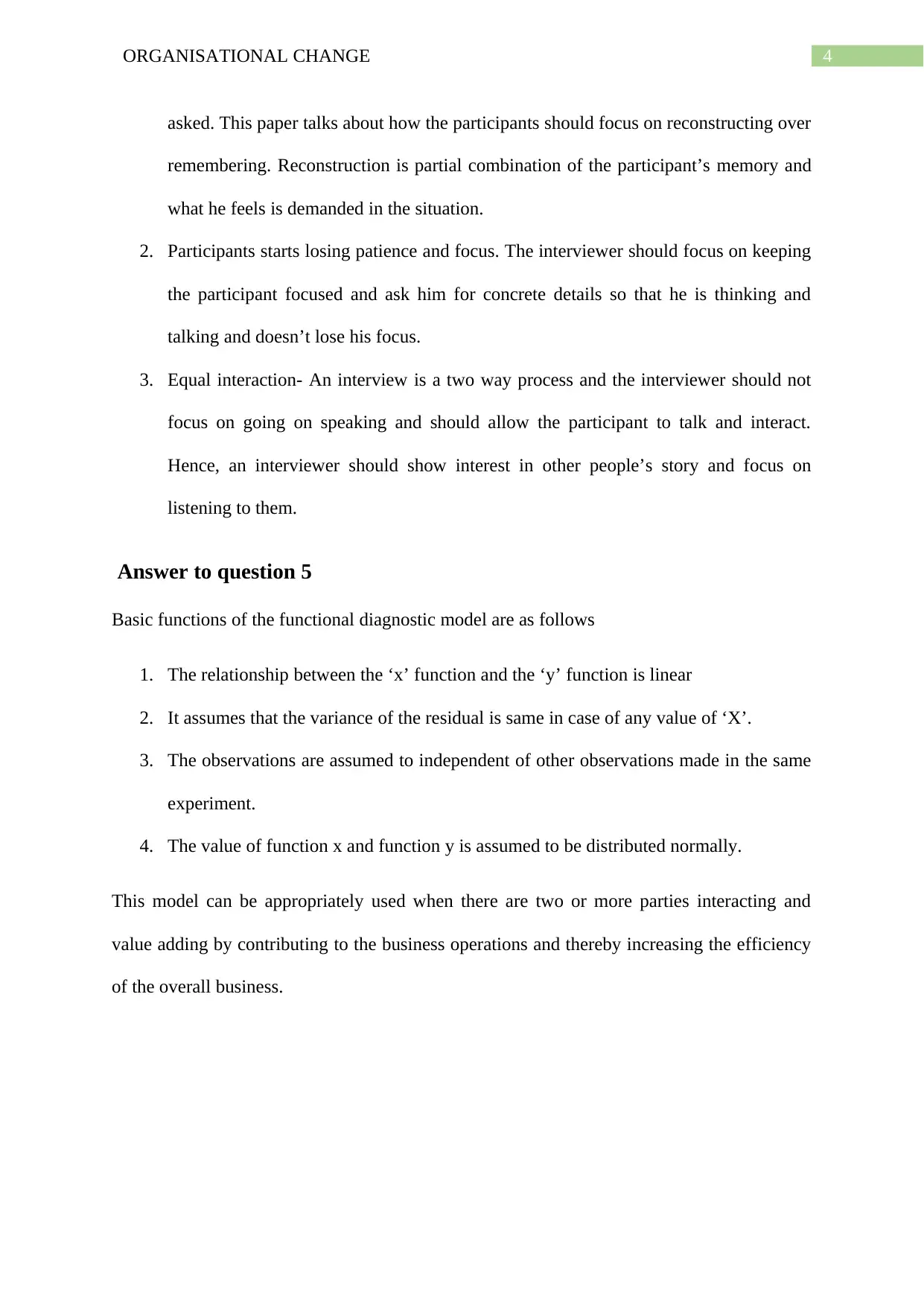
4ORGANISATIONAL CHANGE
asked. This paper talks about how the participants should focus on reconstructing over
remembering. Reconstruction is partial combination of the participant’s memory and
what he feels is demanded in the situation.
2. Participants starts losing patience and focus. The interviewer should focus on keeping
the participant focused and ask him for concrete details so that he is thinking and
talking and doesn’t lose his focus.
3. Equal interaction- An interview is a two way process and the interviewer should not
focus on going on speaking and should allow the participant to talk and interact.
Hence, an interviewer should show interest in other people’s story and focus on
listening to them.
Answer to question 5
Basic functions of the functional diagnostic model are as follows
1. The relationship between the ‘x’ function and the ‘y’ function is linear
2. It assumes that the variance of the residual is same in case of any value of ‘X’.
3. The observations are assumed to independent of other observations made in the same
experiment.
4. The value of function x and function y is assumed to be distributed normally.
This model can be appropriately used when there are two or more parties interacting and
value adding by contributing to the business operations and thereby increasing the efficiency
of the overall business.
asked. This paper talks about how the participants should focus on reconstructing over
remembering. Reconstruction is partial combination of the participant’s memory and
what he feels is demanded in the situation.
2. Participants starts losing patience and focus. The interviewer should focus on keeping
the participant focused and ask him for concrete details so that he is thinking and
talking and doesn’t lose his focus.
3. Equal interaction- An interview is a two way process and the interviewer should not
focus on going on speaking and should allow the participant to talk and interact.
Hence, an interviewer should show interest in other people’s story and focus on
listening to them.
Answer to question 5
Basic functions of the functional diagnostic model are as follows
1. The relationship between the ‘x’ function and the ‘y’ function is linear
2. It assumes that the variance of the residual is same in case of any value of ‘X’.
3. The observations are assumed to independent of other observations made in the same
experiment.
4. The value of function x and function y is assumed to be distributed normally.
This model can be appropriately used when there are two or more parties interacting and
value adding by contributing to the business operations and thereby increasing the efficiency
of the overall business.
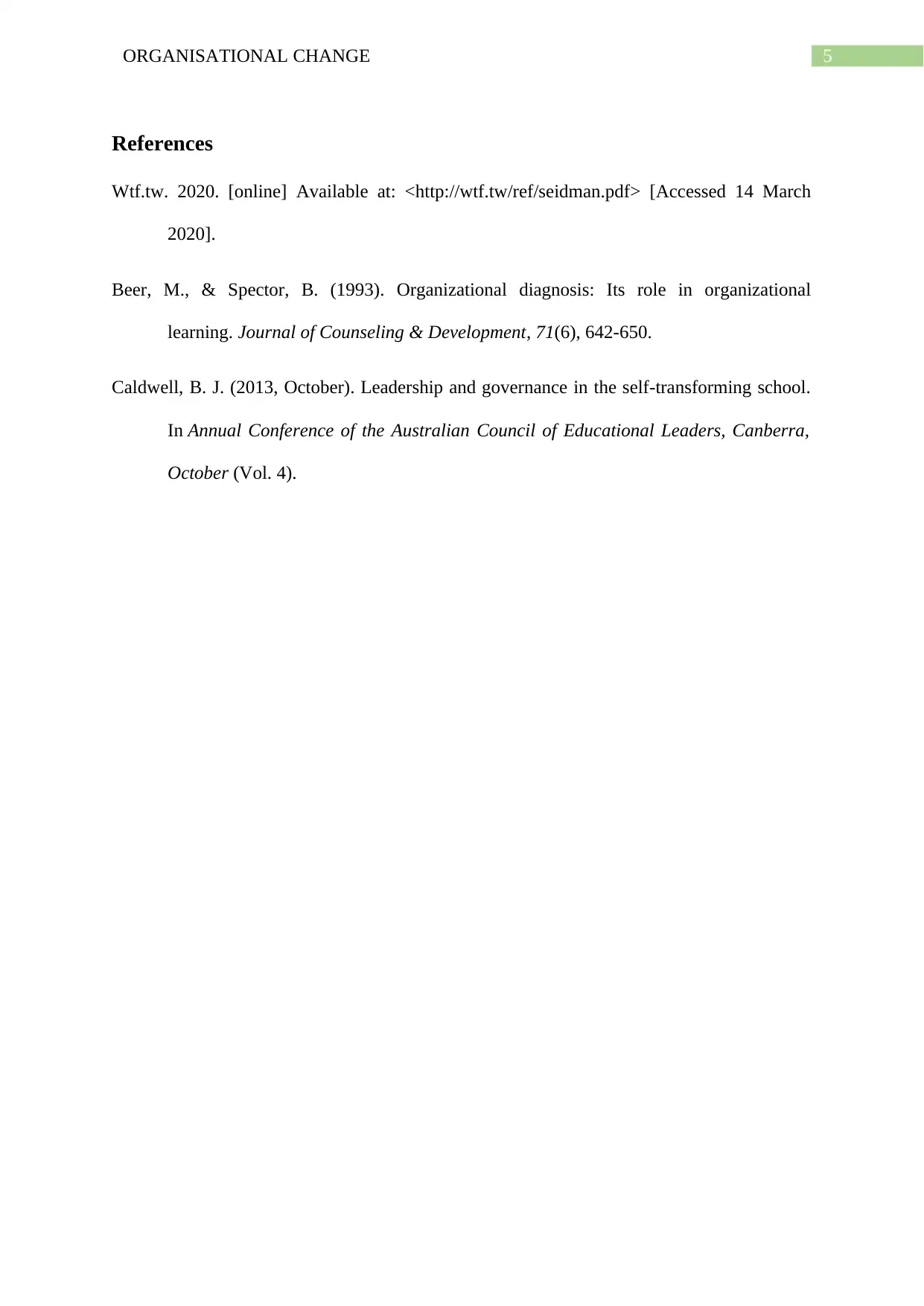
5ORGANISATIONAL CHANGE
References
Wtf.tw. 2020. [online] Available at: <http://wtf.tw/ref/seidman.pdf> [Accessed 14 March
2020].
Beer, M., & Spector, B. (1993). Organizational diagnosis: Its role in organizational
learning. Journal of Counseling & Development, 71(6), 642-650.
Caldwell, B. J. (2013, October). Leadership and governance in the self-transforming school.
In Annual Conference of the Australian Council of Educational Leaders, Canberra,
October (Vol. 4).
References
Wtf.tw. 2020. [online] Available at: <http://wtf.tw/ref/seidman.pdf> [Accessed 14 March
2020].
Beer, M., & Spector, B. (1993). Organizational diagnosis: Its role in organizational
learning. Journal of Counseling & Development, 71(6), 642-650.
Caldwell, B. J. (2013, October). Leadership and governance in the self-transforming school.
In Annual Conference of the Australian Council of Educational Leaders, Canberra,
October (Vol. 4).
⊘ This is a preview!⊘
Do you want full access?
Subscribe today to unlock all pages.

Trusted by 1+ million students worldwide
1 out of 6
Related Documents
Your All-in-One AI-Powered Toolkit for Academic Success.
+13062052269
info@desklib.com
Available 24*7 on WhatsApp / Email
![[object Object]](/_next/static/media/star-bottom.7253800d.svg)
Unlock your academic potential
Copyright © 2020–2025 A2Z Services. All Rights Reserved. Developed and managed by ZUCOL.




